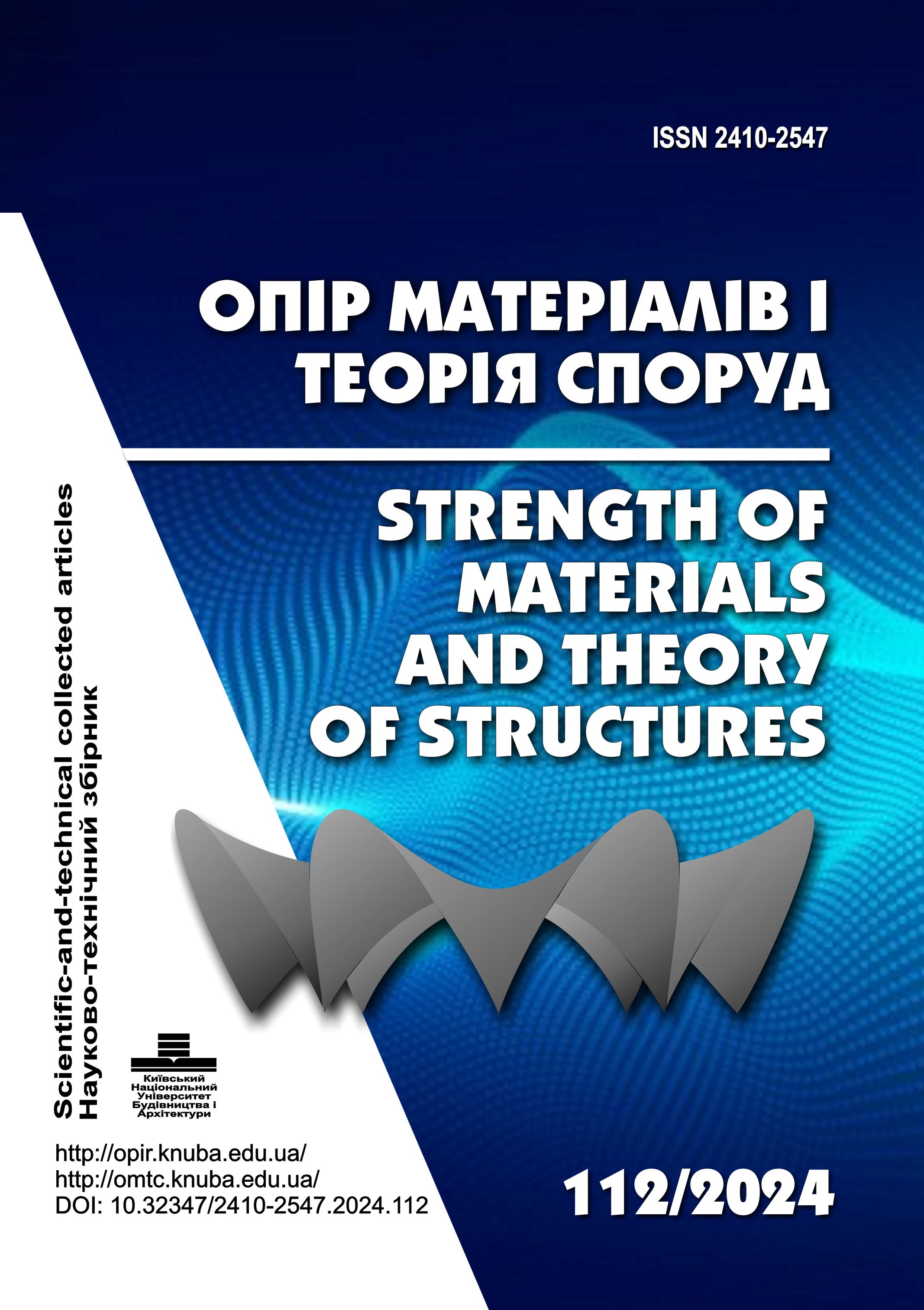Thermally stressed state of asphalt concrete layer on a metal base
DOI:
https://doi.org/10.32347/2410-2547.2024.112.195-201Keywords:
bridge structure, asphalt concrete pavement, thermal effects, shear thermal stress, normal thermal stressAbstract
The results of a finite element study of the thermally stressed and deformed states of a fragment of a two-layer bridge structure, consisting of a bearing metal orthotropic slab with a layer of asphalt concrete applied on it, are presented. It is believed that the materials of the layers are characterized by different thermomechanical parameters, which determine the inhomogeneity of the stress and strain fields. An analogue of these phenomena can be the effect of transformation in electric thermal relays of thermal action on a bimetallic plate with different coefficients of thermal linear expansion into its mechanical displacements, which are used to actuate the switch and switches.
Using the method of computer modeling, it was found that these factors lead to the concentration of stresses and strains and changes in the stress-strain state in all elements of the bridge structure end are not taken into account in the modern practice of designing and operating bridges, as well as are one of the reasons for the premature destruction of asphalt concrete pavements. To eliminate these shortcomings, on the basis of finite element algorithms, a theoretical analysis of the thermally stressed state of a metal bridge slab with an asphalt concrete pavement at various ratios of their thicknesses is carried out. It is shown that an increase in the thickness of the upper layer can lead to an increase in shear and normal tensile stresses initiated in it. Therefore, when designing bridge structures, these features should be additionally taken into account.
References
Gaidaichuk V.V., Mozgovoj V.V., Gustelev O.O, Shevchuk L.V. Analiz deformuvannia dorozhnoho pokryttia na metalevii plyti pivdennoho mosta (Analysis of pavement deformation on the metal slab of the south bridge). Industrial construction and engineering structures, 2019, №1, P.31 – 39.
Gaidaichuk V.V., Mozgovoj V.V., Zaets Yu. A., Shevchuk L.V. Modeliuvannia napruzheno-deformovanoho stanu konstruktsii dorozhnoho odiahu pid diieiu transportnykh navantazhen (Modeling the stress-strain state of a pavement structure under the influence of transport loads). Strength of Materials and Theory of Structures: Scientific-and-technical collected articles, 2017, Issue 99, P. 45-57.
Gaidaichuk V.V., Shevchuk L.V., Bilobrytska O.І., Baran S.A. Kontsentratsiia napruzhen v okoli vertykalnykh trishchyn dorozhnikh pokryttiv (Stress concentration in the vicinity of road сoating cracks). Strength of Materials and Theory of Structures: Scientific-and-technical collected articles, 2021, Issue 106, P. 41-53.
Gulyayev V.I., Gaydaychuk V.V., Mozgoviy V.V., Zaets Yu. A., Shevchuk L.V., Shlyun N.V. Thermoelastic state of multilayer road surfaces (Termopruzhnyi stan bahatosharovykh dorozhnikh pokryttiv). K.: NTU, 2018, 272 pp
Gulyayev V.I., Gaydaychuk V.V., Mozgoviy V.V., Gustelev O.O, Zaets Yu. A., Shevchuk L.V. Doslidzhennia termonapruzhenoho stanu konstruktsii dorozhnoho odiahu (Study of the thermally stressed state of road pavement structures). Industrial construction and engineering structures, 2017, №1, P.6 – 12.
Gulyayev V.I., Shevchuk L.V., Kutsman O. M. Sezonnyi pererozpodil poliv napruzhen v konstruktsiiakh sharuvatykh pokryttiv dorih pid diieiu transportnykh navantazhen (Seasonal redistribution of stress fields in layered road structures under transport load action). Visnyk Natsionalnoho transportnoho universytetu, 2018, V. 40, P. 98 – 105.
Kovalev Ya.N. Avtomobilni dorohy (Car roads), Minsk: Art Design, 2006, 352 p.
Kovalenko A.D. Thermoelasticity: Basic Theory and Applications, Wolters-Noordhoff, Groningen: The Netherlands, 1972.
Mozgoviy V.V., Onyshchenko A.M., Riznichenko O.S. Metodyka proektuvannia asfaltobetonnykh shariv znosu dlia miskykh umov (Methodology for designing asphalt concrete wear layers for urban environments). Visnyk Natsionalnoho transportnoho universytetu, 2010, P. 46 – 50.
Mozgoviy V.V. Povyshenye hydroyzoliatsyonnoi sposobnosty asfaltobetonnoho pokrytyia (Increasing the waterproofing ability of asphalt concrete pavement). Problems of mechanics and construction of transport structures: Proceedings of the II International Scientific and Practical Conference. Almaty, 2015, Р.54-60.
Nowacki W. Thermoelasticity, 2 nd ed. Oxford: PWN – Polish Scientific Publishers, Warsaw and Pergamon Press, 1986.
Perelmuter A. V., Slyvner V.І. Raschetnye medely sooruzhenyi i vozmozhnost yikh analyza (Calculation models of structures and the possibility of their analysis). M.: DMK Press, 2007, 600 p.
Radovskiy B., Teltayev B. Viscoelastic Properties of Asphalts Basedon Penetration and Softening Point. Monograph. –Springer Nature, Switzerland, 2017, P.107.
Sendetsky Dzh. Mekhanyka kompozytnykh materialov (Mechanics of composite materials). T.2.M.: Myr, 1978, 566 p.
Takenaka K. Negative thermal expansion materials: technological key for control of thermal expansion. Science and Technology of Advanced Materials, 2012, V. 13, P.1-11.
Chanh N., Khauies F. Nelineinye synhuliarnovozmushchennye kraevye zadachi (Nonlinear singularly perturbed boundary value problems). M.: Myr, 1988, 247 p.
Bahia H.U., Zeng M., Nam K. Consideration of strain at failure and strength in prediction of pavement thermal cracking. J AAPT, 2000, 69, P. 497–535.
Bouldin M.G., Dongré R., Rowe G.M., Sharrock M.J., Anderson D.A. Predicting thermal cracking of pavements from binder properties. AAPT, 2000, 69, P. 455–496.
Chen EY, Pan GE, Norfolk TS, Wang O (2011) Surface loading of a multilayered viscoelastic pavement. Road Mat Pav Des 12: 849–874.
Herve Di Benedetto, Louis Francken Mechanicatests for bituminous materials. Recent improvements and future prospects. – Proceedings of the fifthinternational rilem symposium MTBM LYON 97/France/14-16 MAI 1997, P. 353-355.
Molenaar A.A., Li N. Prediction of compressive and tensile strength of asphalt concrete. Int J Pav Res Tech, 2014, 7, P. 324–331.
Radovskiy B., Mozgovoy V. Ways to reduce low temperature cracking in Asphalt Pavements. In: 4th Euro bitumen Symposium, Madrid, 1989.
Yoder E.J. Principles of pavement design. New York. John Wiley&sons, INC. London. Chapman&Hall, Ltd. 1991.
Downloads
Published
Issue
Section
License

This work is licensed under a Creative Commons Attribution 4.0 International License.
Authors retain copyright and grant the journal right of first publication with the work simultaneously licensed under a Creative Commons Attribution License that allows others to share the work with an acknowledgement of the work's authorship and initial publication in this journal.

